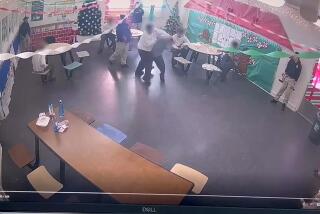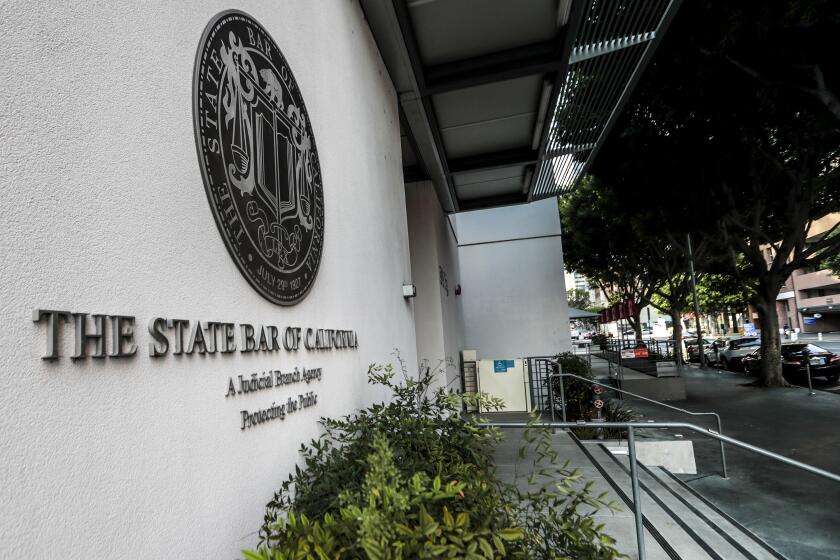Guards at Youth Prison Accused of Abusing Inmates
- Share via
SACRAMENTO — The state’s inspector general has uncovered a pattern of excessive force and abusive treatment of inmates at the California Youth Authority’s flagship institution in Chino, where improper discipline regularly was meted out, according to a top state official.
A six-month investigation found that officers exercised their own brand of justice outside regular channels, allegedly slamming handcuffed inmates against walls; firing potentially lethal riot control guns at close range to remove inmates from cells; forcing unruly inmates into cells with urine and excrement on the floor; and ordering that disorderly inmates be injected with antipsychotic drugs.
One of the most disturbing disclosures, contained in what state officials describe as a status report to Gov. Gray Davis, is that guards would test the readiness of inmates to be sent to the facility’s general population by forcing them to confront other inmates, often rival gang members, in what were referred to as “the Friday night fights.”
When inmates attempted to complain about the abuse, their grievances often fell on deaf ears and were never sent up the chain of command, according to the findings.
The investigation at the Heman G. Stark Youth Correctional Facility is likely to spread to other CYA facilities--which handle juvenile offenders from ages 12 to 25--said a high-ranking administration official who is familiar with the investigation and the status report.
One youth authority administrator has been removed from his job, partly because of what turned up during the inspector general’s probe, according to Davis administration officials.
“You have essentially a hermetically sealed environment,” the official who has seen the probe results said. “If there’s abuse, if the institution lacks integrity and if wards are being injured or mistreated and there’s no way to illuminate it and stop it, then it has a frightening dimension. This is scary stuff.”
Davis, who gave Inspector General Steve White carte blanche to pursue the probe and who has personally kept tabs on it, said in a strongly worded letter Friday that the investigation “has yielded very serious findings that place the safety of both wards and staff at risk.”
In the letter to Robert Presley, the administration’s Cabinet-level secretary for corrections, Davis ordered top corrections officials to take “swift action” to end the improper practices and overhaul the system.
So far, investigators have found that one inmate was temporarily paralyzed and others experienced serious bruises and lacerations. Otherwise, none of the inmates at the San Bernardino County facility suffered any life-threatening injuries during a period that goes back more than two years to the middle of Republican Gov. Pete Wilson’s final term in office.
Don Novey, president of the California Correctional Peace Officers Assn., said Saturday that he was aware of an inquiry at Heman Stark but didn’t know any of the details.
“All I do is represent them [correctional officers]. I don’t cause any of this. No one from management has talked to me,” Novey said.
Frank Alarcon, who served as youth authority director until March, said that in 1997 he sought to shake up the Chino institution’s administration after his own management review. Alarcon, who was appointed by Wilson, said his probe did not stem from complaints of excessive force; a state investigator said it was designed to boost the level of control the staff exercised over inmates.
Told what the inspector’s general office has turned up about abusive disciplinary practices, Alarcon defended his stewardship, saying the allegations of misconduct “never came to my attention.”
“I’d want to see all the facts before I react too strongly,” said Alarcon, now second in command of Florida’s juvenile justice system. Alarcon said he “in no way condoned inappropriate use of force,” but needs to know more about the allegations.
White, a former Sacramento County district attorney, was tabbed by Davis as inspector general, a newly beefed up watchdog post that reports directly to the governor about problems at prisons and the state’s 11 youth authority institutions.
California’s troubled prison system has been the focus of widespread criticism and media scrutiny, and the spotlight on occasion has shined on problems in the youth authority. Earlier this year the superintendent of the Ventura School juvenile prison was demoted and transferred to Heman Stark in the wake of scandals involving mismanagement and sexual misconduct.
Drug Experiments on Inmates Disclosed
Last month, The Times disclosed that Stanford University was allowed to test a powerful psychiatric drug on dozens of teenage inmates in an experiment that the youth authority now believes violated admittedly conflicting state laws. The university and the CYA jointly conducted research in 1997 that the agency’s director said probably was “not in compliance” with a law prohibiting medical research on prisoners.
The youth authority, with more than 7,700 youths and young adults and an annual budget of more than $326 million, is responsible for offenders who are provided instruction and counseling intended to prevent them from reverting to a life of crime.
In April, White’s agents were deployed to Chino for a performance audit that focused on the use of excessive force, according to an official familiar with the investigation. They were soon confronted by staff and inmates bringing forward allegations of misconduct, according to the Davis administration official.
The agents later painted a grim picture, chiefly focused on a security unit, known as the “O and R Building,” where some of the worst of the state’s juvenile offenders are housed in cells for 23 hours a day, sometimes for months on end.
One of the practices uncovered was called “Friday night fights,” a rite of passage designed to persuade inmates to cooperate before they were placed in the general population at the 1,300-inmate facility.
Inmates were required to engage in a test, officially called an “unrestrained program,” in which prisoners would be sent into a room, released from their handcuffs and told to sit for 10 to 15 minutes next to another offender--often a rival gang member--to test their joint readiness to leave the lockup and enter the facility’s general population.
Davis administration officials estimate that at least 24% of the time--in incidents involving perhaps hundreds of youths--the test quickly turned ugly with the inmates engaging in fights that had to be stopped by pepper spray or the firing of a riot control gun.
In some instances, state officials interviewed by The Times suggest, the guards set up situations in which they knew the inmates would come to blows. Such behavior would prevent them from being allowed to join the general population.
“In many of these cases, it’s virtually a 100% certainty [a fight would happen] because if you put a Crip and Blood together they are going to fight,” said the administration official, who is familiar with the details of the probe and the status report on its findings.
On Friday, Davis ordered Presley to “immediately discontinue” the practice.
The “Friday night fights” are a troubling--though much more restrained--echo of what happened in recent years at Corcoran State Prison, where rival gang members were placed in exercise yards as part of a policy to mix gangs. Prison officials said they needed to see if sworn enemies could get along in a small setting before releasing them into the general population. The practice often resulted in stand-up fistfights and was eventually halted.
At Heman Stark, investigators are not aware of any inmates who were killed or permanently injured. By contrast, at Corcoran over the last decade or so, guards killed seven inmates engaged in fistfights with fellow prisoners.
At least 10% of the CYA inmates in the “O and R Building” have serious mental health problems, and doctors have filled out open-ended drug prescriptions, the Davis administration official said. As a consequence, when one of the inmates in the 100-person unit is disruptive, he could be forcibly restrained and injected with antipsychotic drugs without the direct supervision of a physician.
In other instances, the wards have faced a series of what the administration official called “informal sanctions,” which include being directed to enter cells with urine and feces on the ground and, if they balk, being sprayed with pepper gas or required to sit naked or nearly naked in a cell for 24 hours.
Another variation on this informal discipline system is called “slamming.” Guards would lead handcuffed inmates to blind spots out of the range of video cameras in the aging facility and allegedly throw the inmate to the ground or against a cell, sometimes causing lacerations that wouldn’t receive medical attention for 24 hours.
Another problem area, the administration official said, was the way inmates have been forcibly removed from cells. The official noted that the inmates had often been disorderly--perhaps having “gassed” a guard, meaning they had tossed feces or urine at the officer.
To remove the inmate, extraction teams would sometimes fire a 37-millimeter riot control gun at extremely close range--once from just 3 1/2 feet away--the official said.
Officers are trained to skip the hockey puck-like projectiles off the ground, the official said, because from a range of less than 10 feet the projectiles can be lethal.
The administration official said some of the shots resulted in serious bruises, and in one instance a youth was temporarily paralyzed after being shot in the thigh.
In his letter Friday, Davis prohibited the use of “open prescriptions” that can be administered outside proper medical protocols and ordered that “all ward grievances must be investigated.”
Michael Bustamante, the governor’s press secretary, said, “The findings that have been uncovered by the inspector general are very disturbing, and it appears that some of these problems have been going on for some time.”
More to Read
Sign up for Essential California
The most important California stories and recommendations in your inbox every morning.
You may occasionally receive promotional content from the Los Angeles Times.










